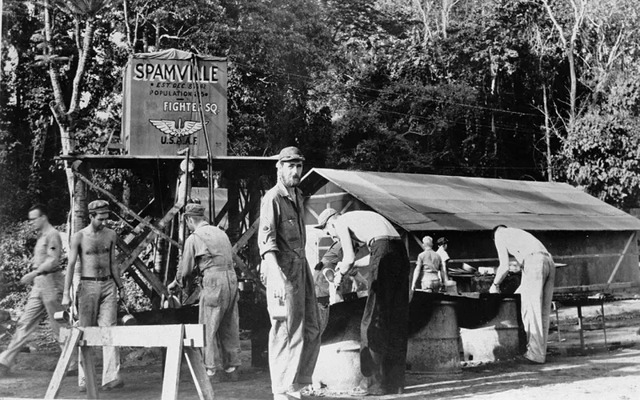Hormel Spiced Ham, was created in 1927. It was an inexpensive luncheon meat to help housewives stretch their budget dollars. The Great Depression caused sales to drop, and company president Jay Hormel decided to relaunch the product with a glitzy marketing campaign. Jay Hormel threw a party on New Year’s Eve 1936. Guests were asked to submit their most creative names. An actor named Kenneth Daigneau, wrote down Spam. Hormel loved the name, and Daigneau won $100. Spam was then born in 1937 when the Hormel Foods Corporation introduced the iconic canned pork product to the American public. However, its true journey to fame began during World War II. With resources diverted to support the war effort, many essential food items became scarce. Fresh meats were rationed and often in short supply, making it challenging to provide a stable and nutritious diet for troops and civilians. The need for a durable and protein-rich food option became evident.
With food rationing in full swing, Spam quickly became a popular and accessible source of protein for soldiers and civilians alike. Its long shelf life and versatility made it an essential part of the American diet during the war years. Spam, when it was first introduced was basically canned pork product made from ham, pork shoulder, salt, water, sugar, and sodium nitrite. Its long shelf life, convenience, and affordability made it an attractive option for the military and civilians during the war. Some people of course hated Spam, but they take it for granted how refined the canning process became over time. A cartoon in Life Magazine depicts an angry GI waving a slice of luncheon meat at the cook, as he shouts, “Whadya mean luncheon meat? I say it’s Spam and I say to hell with it!” In Tom Geoghegan’s article “The story of how the tin can nearly wasn’t” he noted the scandal that might have derailed the canning industry during the 1800’s as inspectors found putrid meat in cans due to be shipped to the English Navy. Read my article here.
Let’s be real; Spam could be worse. I actually like it a lot.
Geoghegan wrote, “they fished out pieces of heart, rotting tongues from a dog or sheep, offal, blood, a whole kidney “perfectly putrid”, ligaments and tendons and a mass of pulp. Some organs appeared to be from diseased animals.” A nationwide inspection began on the meat-canning industry in the 1830’s.
Spam quickly became a staple in the diet of American soldiers serving on the front lines. Its compact size, easy storage, and ability to be eaten both cold and hot made it a reliable and convenient source of sustenance during long campaigns and in challenging conditions. On the home front, Spam found its way onto kitchen tables across the United States. Families incorporated it into a wide array of recipes, from sandwiches and stews to casseroles and meatloaf. Spam became synonymous with resilience and adaptability, reflecting the spirit of a nation united in the face of adversity. Shipments of Spam were included in the aid transported to Great Britain and the Soviet Union.
Gen. Dwight Eisenhower wrote a letter to a retired Hormel executive commenting on his company’s famous product after the War. “During World War II, of course, I ate my share of Spam along with millions of other soldiers. I’ll even confess to a few unkind remarks about it—uttered during the strain of battle, you understand. But as former Commander-in-Chief, I believe I can still officially forgive you your only sin: sending us so much of it.”
For many Americans, Spam represented more than just a canned meat product. It symbolized patriotism and a willingness to sacrifice and endure hardships for the greater good. After World War II, Spam’s popularity continued to grow, leading to its introduction in various countries around the world. Its expansion was facilitated by the United States military, which introduced Spam to troops stationed overseas. As a result, Spam became ingrained in the culinary traditions of many nations, earning unique nicknames such as “Spam musubi” in Hawaii and “budae jjigae” in South Korea.
Spam musubi. [Photo: Janine/Flickr]
As the world moved into the post-war era, Hormel Foods continued to innovate with different varieties of Spam. They introduced low-sodium, turkey, and bacon-flavored Spam, catering to changing consumer preferences and dietary needs. These innovations helped keep Spam relevant and appealing to new generations of consumers.
Spam’s influence extended beyond the kitchen, finding its way into pop culture, literature, and even the Monty Python comedy sketch “Spam” in the 1970s. The sketch popularized the term “spam” as internet jargon for unsolicited emails, forever associating the word with this famous canned meat.
While some may joke about Spam, its versatility and ability to take on different flavors have sparked culinary creativity worldwide. From gourmet Spam dishes in high-end restaurants to comfort food favorites at family gatherings, Spam has proven that it can adapt to any cuisine and delight taste buds everywhere. Hormel has sold over eight billion cans in 44 countries since 1937. More than 10 varieties of SPAM are available on the market.
Today, Spam enjoys a nostalgic following among those who remember its significance during wartime rationing. At the same time, younger generations embrace it for its convenience and unique taste. Spam has also found a place in emergency food supplies, backpacking trips, and survival kits due to its long shelf life and high nutritional value.
Source
https://www.smithsonianmag.com/food/how-spam-went-canned-necessity-american-icon-180963916/
https://www.britannica.com/topic/SPAM-food
*The views and opinions expressed on this website are solely those of the original authors and contributors. These views and opinions do not necessarily represent those of Spotter Up Magazine, the administrative staff, and/or any/all contributors to this site.
Eat Drink and be Merry: Why You Should Store Canned Food at Home



